I received the same interview question. I am a C++ candidate but I was in a position to code relatively fast in JAVA.
Java [Courtesy : Sumod Mathilakath]
import java.io.*;
import java.util.*;
class UserMainCode
{
public String GetSubString(String input1,String input2){
// Write code here...
return find(input1, input2);
}
private static boolean containsPatternChar(int[] sCount, int[] pCount) {
for(int i=0;i<256;i++) {
if(pCount[i]>sCount[i])
return false;
}
return true;
}
public static String find(String s, String p) {
if (p.length() > s.length())
return null;
int[] pCount = new int[256];
int[] sCount = new int[256];
// Time: O(p.lenght)
for(int i=0;i<p.length();i++) {
pCount[(int)(p.charAt(i))]++;
sCount[(int)(s.charAt(i))]++;
}
int i = 0, j = p.length(), min = Integer.MAX_VALUE;
String res = null;
// Time: O(s.lenght)
while (j < s.length()) {
if (containsPatternChar(sCount, pCount)) {
if ((j - i) < min) {
min = j - i;
res = s.substring(i, j);
// This is the smallest possible substring.
if(min==p.length())
break;
// Reduce the window size.
sCount[(int)(s.charAt(i))]--;
i++;
}
} else {
sCount[(int)(s.charAt(j))]++;
// Increase the window size.
j++;
}
}
System.out.println(res);
return res;
}
}
C++ [Courtesy : sundeepblue]
#include <iostream>
#include <vector>
#include <string>
#include <climits>
using namespace std;
string find_minimum_window(string s, string t) {
if(s.empty() || t.empty()) return;
int ns = s.size(), nt = t.size();
vector<int> total(256, 0);
vector<int> sofar(256, 0);
for(int i=0; i<nt; i++)
total[t[i]]++;
int L = 0, R;
int minL = 0; //gist2
int count = 0;
int min_win_len = INT_MAX;
for(R=0; R<ns; R++) { // gist0, a big for loop
if(total[s[R]] == 0) continue;
else sofar[s[R]]++;
if(sofar[s[R]] <= total[s[R]]) // gist1, <= not <
count++;
if(count == nt) { // POS1
while(true) {
char c = s[L];
if(total[c] == 0) { L++; }
else if(sofar[c] > total[c]) {
sofar[c]--;
L++;
}
else break;
}
if(R - L + 1 < min_win_len) { // this judge should be inside POS1
min_win_len = R - L + 1;
minL = L;
}
}
}
string res;
if(count == nt) // gist3, cannot forget this.
res = s.substr(minL, min_win_len); // gist4, start from "minL" not "L"
return res;
}
int main() {
string s = "abdccdedca";
cout << find_minimum_window(s, "acd");
}
Erlang [Courtesy : wardbekker]
-module(leetcode).
-export([min_window/0]).
%% Given a string S and a string T, find the minimum window in S which will contain all the characters in T in complexity O(n).
%% For example,
%% S = "ADOBECODEBANC"
%% T = "ABC"
%% Minimum window is "BANC".
%% Note:
%% If there is no such window in S that covers all characters in T, return the emtpy string "".
%% If there are multiple such windows, you are guaranteed that there will always be only one unique minimum window in S.
min_window() ->
"eca" = min_window("cabeca", "cae"),
"eca" = min_window("cfabeca", "cae"),
"aec" = min_window("cabefgecdaecf", "cae"),
"cwae" = min_window("cabwefgewcwaefcf", "cae"),
"BANC" = min_window("ADOBECODEBANC", "ABC"),
ok.
min_window(T, S) ->
min_window(T, S, []).
min_window([], _T, MinWindow) ->
MinWindow;
min_window([H | Rest], T, MinWindow) ->
NewMinWindow = case lists:member(H, T) of
true ->
MinWindowFound = fullfill_window(Rest, lists:delete(H, T), [H]),
case length(MinWindow) == 0 orelse (length(MinWindow) > length(MinWindowFound)
andalso length(MinWindowFound) > 0) of
true ->
MinWindowFound;
false ->
MinWindow
end;
false ->
MinWindow
end,
min_window(Rest, T, NewMinWindow).
fullfill_window(_, [], Acc) ->
%% window completed
Acc;
fullfill_window([], _T, _Acc) ->
%% no window found
"";
fullfill_window([H | Rest], T, Acc) ->
%% completing window
case lists:member(H, T) of
true ->
fullfill_window(Rest, lists:delete(H, T), Acc ++ [H]);
false ->
fullfill_window(Rest, T, Acc ++ [H])
end.
REF:




